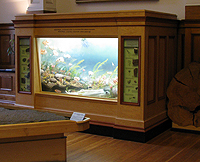 This diorama shows how Montreal may have looked almost half a billion years ago. Much of the rock dug out of quarries in the Montreal area is limestone, a type of sedimentary rock formed of coral and shells, that was laid down during the Ordovician period. This Montreal limestone is commonly used in construction with the result that fossils can be seen in many of the buildings of the city. For more information about finding fossils in the building stones of Montreal see the Redpath Museum's book What Building Stones Tell or this condensed version.
This diorama shows how Montreal may have looked almost half a billion years ago. Much of the rock dug out of quarries in the Montreal area is limestone, a type of sedimentary rock formed of coral and shells, that was laid down during the Ordovician period. This Montreal limestone is commonly used in construction with the result that fossils can be seen in many of the buildings of the city. For more information about finding fossils in the building stones of Montreal see the Redpath Museum's book What Building Stones Tell or this condensed version.
What is the Ordovician?
The Ordovician period lasted almost fifty million years, from 488 through to 443 million years ago. It is the second period in the Paleozoic (“old life”) era. To put its age into perspective, dinosaurs wouldn't evolve until over two hundred million years after the Ordovician ended. The world was very different than it is now, much warmer and wetter, with the continents located in different locations. Life teemed in shallow seas, but the land started the period barren and devoid of life. The area where Montreal is now found was located near the equator and under water; a rich tropical aquatic community existed here. This period is named after an ancient tribe of Celts (the Ordovices) who lived in a region in Wales where deposits from this period are found.
How many of these creatures can you find in the diorama?
Brachiopods
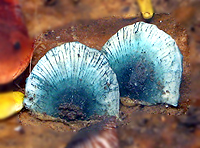 Brachiopods (from the Latin for “arm feet”) are shelled animals whose soft body parts are enclosed between two valves. They may look similar to bivalves such as clams, but the body inside the shell is very different and the valves of the shell have a different symmetry than clams (left/right instead of top/bottom). A muscular stalk (the pedicle) usually emerges from the larger of the two valves and attaches the brachiopod to the sea floor. Brachiopods were phenomenally abundant during the Paleozoic (the three hundred million or so years before the dinosaurs), far more so than bivalves, until they were severely affected at the end of the Paleozoic by the Permian mass extinction and overtaken in abundance by bivalves. While over 30 000 fossil species are known only 300-500 species exist today. One genus, Lingula, is noteworthy for having remained virtually unchanged for over half a billion years.
Brachiopods (from the Latin for “arm feet”) are shelled animals whose soft body parts are enclosed between two valves. They may look similar to bivalves such as clams, but the body inside the shell is very different and the valves of the shell have a different symmetry than clams (left/right instead of top/bottom). A muscular stalk (the pedicle) usually emerges from the larger of the two valves and attaches the brachiopod to the sea floor. Brachiopods were phenomenally abundant during the Paleozoic (the three hundred million or so years before the dinosaurs), far more so than bivalves, until they were severely affected at the end of the Paleozoic by the Permian mass extinction and overtaken in abundance by bivalves. While over 30 000 fossil species are known only 300-500 species exist today. One genus, Lingula, is noteworthy for having remained virtually unchanged for over half a billion years.
Bryozoans
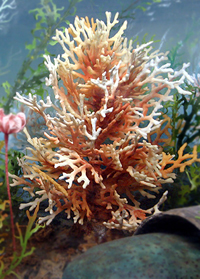 Bryozoans, also known as moss animals (their name comes from the Greek for “moss animacule”), are small colonial animals that create a branching skeleton of calcium carbonate on hard surfaces. Each individual animal, known as a zooid, is usually less than a millimetre long and lives in its own tiny compartment. Colonies can be metres in size, composed of millions of zooids, and have many different shapes, including branching and fanlike. Individuals in colonies have different tasks, such as cleaning, gathering food, or strengthening the colony. Bryozoans feed by creating a current that draws water and any tiny creatures in it (mostly tiny plant-like organisms called phytoplankton) to the creature’s mouth. Bryozoans arose during the Ordovician and were important reef builders during that period. The commonly-found fossils of their colonies look like textured twigs. Bryozoans still exist today, although they are nowhere near as common and it is corals that form most reefs today.
Bryozoans, also known as moss animals (their name comes from the Greek for “moss animacule”), are small colonial animals that create a branching skeleton of calcium carbonate on hard surfaces. Each individual animal, known as a zooid, is usually less than a millimetre long and lives in its own tiny compartment. Colonies can be metres in size, composed of millions of zooids, and have many different shapes, including branching and fanlike. Individuals in colonies have different tasks, such as cleaning, gathering food, or strengthening the colony. Bryozoans feed by creating a current that draws water and any tiny creatures in it (mostly tiny plant-like organisms called phytoplankton) to the creature’s mouth. Bryozoans arose during the Ordovician and were important reef builders during that period. The commonly-found fossils of their colonies look like textured twigs. Bryozoans still exist today, although they are nowhere near as common and it is corals that form most reefs today.
Carpoid echinoderm (extinct)
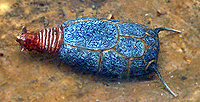 During the Ordovician the echinoderms (which includes starfish, sea urchins and crinoids) evolved a large number of forms, many of which have since gone extinct (only five classes exist today out of the twenty or so that were around in the Ordovician). Although all currently existing echinoderms have fivefold radial symmetry, some earlier forms did not, such as this interesting carpoid, about which little is known. The stubby “tail” is actually a single arm at one end, with the mouth on the underside of the body. The arm was probably used for movement and feeding, and they most likely scavenged or were suspension feeders. Some researchers think that they are actually chordates (the group of which we are members), but it’s generally accepted that they are echinoderms. They were never very common, and went extinct in the late Carboniferous.
During the Ordovician the echinoderms (which includes starfish, sea urchins and crinoids) evolved a large number of forms, many of which have since gone extinct (only five classes exist today out of the twenty or so that were around in the Ordovician). Although all currently existing echinoderms have fivefold radial symmetry, some earlier forms did not, such as this interesting carpoid, about which little is known. The stubby “tail” is actually a single arm at one end, with the mouth on the underside of the body. The arm was probably used for movement and feeding, and they most likely scavenged or were suspension feeders. Some researchers think that they are actually chordates (the group of which we are members), but it’s generally accepted that they are echinoderms. They were never very common, and went extinct in the late Carboniferous.
Cephalopods – the dominant predators
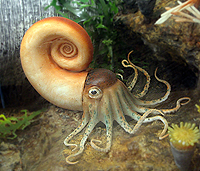 These squid-like cephalopods are molluscs, and the name means “head foot”. The animal lived at the front end f the long tube-like chambered shell, regulating their buoyancy by the amount of air in the chambers of their shell. They looked like squids in a protective shell, and indeed modern squids, hundreds of millions of years descended from these predators, still have a remnant of this shell, reduced to a relatively small internal structure. These large predators at the top of the food chain used their strong tentacles to capture food, like trilobites, and could jet around by forcefully expelling air out from their body. The mouth is a beak-like structure in the centre of the tentacles. Up to the end of the Cambrian cephalopods were rare and small, but they came into their own in the Ordovician and became the top predators.
These squid-like cephalopods are molluscs, and the name means “head foot”. The animal lived at the front end f the long tube-like chambered shell, regulating their buoyancy by the amount of air in the chambers of their shell. They looked like squids in a protective shell, and indeed modern squids, hundreds of millions of years descended from these predators, still have a remnant of this shell, reduced to a relatively small internal structure. These large predators at the top of the food chain used their strong tentacles to capture food, like trilobites, and could jet around by forcefully expelling air out from their body. The mouth is a beak-like structure in the centre of the tentacles. Up to the end of the Cambrian cephalopods were rare and small, but they came into their own in the Ordovician and became the top predators.
 Orthocone cephalopods, which had a straight shell and could reach lengths of five metres, were extinct by the end of the Triassic, but their straight shell shape arose many times in cephalopods. The curved shape of the shell of the smaller cephalopod indicates that it is an ammonite cephalopod. Shells were once very common in cephalopods, but now only the nautilus still has a full shell, the modern other groups having reduced the shell to a relatively small internal structure or eliminated it entirely. The modern cephalopods are the squid, octopus, nautilus and cuttlefish.
Orthocone cephalopods, which had a straight shell and could reach lengths of five metres, were extinct by the end of the Triassic, but their straight shell shape arose many times in cephalopods. The curved shape of the shell of the smaller cephalopod indicates that it is an ammonite cephalopod. Shells were once very common in cephalopods, but now only the nautilus still has a full shell, the modern other groups having reduced the shell to a relatively small internal structure or eliminated it entirely. The modern cephalopods are the squid, octopus, nautilus and cuttlefish.
Clams
 The Pelecypoda (“hatchet feet”) or Bivalva (“two valves”) is a mollusk group that includes clams, scallops, oysters and mussels. These animals secrete two similarly-shaped valves (which are to the left and right of the body) that are joined along a hinge by teeth and an elastic ligament. Pelecypods are filter feeders. The shells are kept open during feeding and two siphons or tubes are used to bring in food and exhaust waste material, respectively. When endangered, the shells close firmly. Some species can “clap” their shells and use the jets of water to propel themselves away from predators. There are currently around 30 000 pecies of bivalves. Externally, they look very similar to brachiopods and have a very similar lifestyle, but the two groups are not closely related. In the Ordovician it was the brachiopods who were far more common, but after the Permian mass extinction the bivalves overtook them.
The Pelecypoda (“hatchet feet”) or Bivalva (“two valves”) is a mollusk group that includes clams, scallops, oysters and mussels. These animals secrete two similarly-shaped valves (which are to the left and right of the body) that are joined along a hinge by teeth and an elastic ligament. Pelecypods are filter feeders. The shells are kept open during feeding and two siphons or tubes are used to bring in food and exhaust waste material, respectively. When endangered, the shells close firmly. Some species can “clap” their shells and use the jets of water to propel themselves away from predators. There are currently around 30 000 pecies of bivalves. Externally, they look very similar to brachiopods and have a very similar lifestyle, but the two groups are not closely related. In the Ordovician it was the brachiopods who were far more common, but after the Permian mass extinction the bivalves overtook them.
Conularids (extinct)
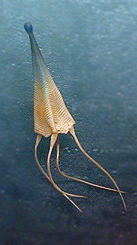 Conularids are a poorly-known group that are tentatively given their own phylum (Conulariida) and assumed to be related to the Cnidaria (jellyfish, corals and anemones). The most easily-fossilized part is their unique four-sided ridged cone that was made of calcium phosphate. The lack of good fossils for this group means that the earlier interpretation shown in the diorama, with the conularids floating in the water like armoured pyramid-shaped jellyfish, is incorrect. A holdfast at the pointed end of the cone actually kept them anchored in place and tentacles extended from the other end, giving them an appearance something like a sea anemone in an angled shell. Some were up to 30cm long, though most were smaller. They were never very common but managed to exist for a quarter of a billion years, originating in the middle Cambrian (510 million years ago) and finally going extinct in the Lower Triassic (245 million years ago).
Conularids are a poorly-known group that are tentatively given their own phylum (Conulariida) and assumed to be related to the Cnidaria (jellyfish, corals and anemones). The most easily-fossilized part is their unique four-sided ridged cone that was made of calcium phosphate. The lack of good fossils for this group means that the earlier interpretation shown in the diorama, with the conularids floating in the water like armoured pyramid-shaped jellyfish, is incorrect. A holdfast at the pointed end of the cone actually kept them anchored in place and tentacles extended from the other end, giving them an appearance something like a sea anemone in an angled shell. Some were up to 30cm long, though most were smaller. They were never very common but managed to exist for a quarter of a billion years, originating in the middle Cambrian (510 million years ago) and finally going extinct in the Lower Triassic (245 million years ago).
Corals - Rugose (solitary, or horn) corals (extinct)
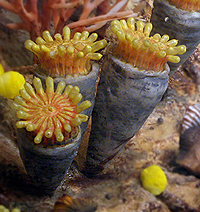 Rugose, or "horn corals", are animals that secreted a horn-shaped exoskeleton and could be up to a metre in length. This coral was either solitary (single) or joined to other corallites to form a colony, which made their characteristic shape less obvious. They captured prey with tentacles, and may have had stinging cells like modern corals. Rugose corals were abundant in the Ordovician, but went extinct at the end of the Permian.
Rugose, or "horn corals", are animals that secreted a horn-shaped exoskeleton and could be up to a metre in length. This coral was either solitary (single) or joined to other corallites to form a colony, which made their characteristic shape less obvious. They captured prey with tentacles, and may have had stinging cells like modern corals. Rugose corals were abundant in the Ordovician, but went extinct at the end of the Permian.
Corals - Round (colonial, or tabulate) corals
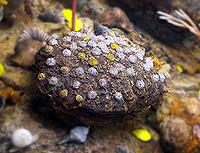 Massive rounded corals occur in areas where the water is warm and shallow, which allows the symbiotic algae in their tissues to photosynthesize in the sunlight. Although most corals do capture and devour prey, the bulk of their energy comes from the algae. Every coral mass is made up of thousands or more of small individual units called polyps, and corals that create a hard exoskeleton build coral reefs over time. The presence of fossil corals in the St. Lawrence lowlands indicates that climactic conditions were once very different than today. During the Ordovician reefs were made primarily by sponges and bryozoans, not corals.
Massive rounded corals occur in areas where the water is warm and shallow, which allows the symbiotic algae in their tissues to photosynthesize in the sunlight. Although most corals do capture and devour prey, the bulk of their energy comes from the algae. Every coral mass is made up of thousands or more of small individual units called polyps, and corals that create a hard exoskeleton build coral reefs over time. The presence of fossil corals in the St. Lawrence lowlands indicates that climactic conditions were once very different than today. During the Ordovician reefs were made primarily by sponges and bryozoans, not corals.
Crinoids
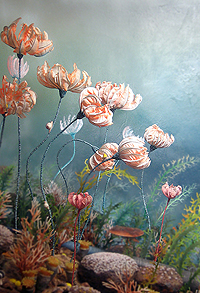 Crinoids, also known as feather stars or sea lilies, are members of the phylum Echinodermata, which also includes sea stars, sea cucumbers and sea urchins, which means that they possess the unique five-fold symmetry of echinoderms. During the Ordovician they generally lived anchored to the sea floor by a stalk that could be metres or even tens of metres long, living in huge underwater prairies, looking more like flowers than the animals they are. Most modern forms don’t have a stem and can crawl or swim, though slowly. They feed by using tiny tube feet on their feather-like branched arms to trap small floating particles of food and then place the food into a groove that runs down the arm. Tiny hairlike cilia then pass the food down the groove to the mouth. The mouth is located in the centre of the “head” or calyx.
Crinoids, also known as feather stars or sea lilies, are members of the phylum Echinodermata, which also includes sea stars, sea cucumbers and sea urchins, which means that they possess the unique five-fold symmetry of echinoderms. During the Ordovician they generally lived anchored to the sea floor by a stalk that could be metres or even tens of metres long, living in huge underwater prairies, looking more like flowers than the animals they are. Most modern forms don’t have a stem and can crawl or swim, though slowly. They feed by using tiny tube feet on their feather-like branched arms to trap small floating particles of food and then place the food into a groove that runs down the arm. Tiny hairlike cilia then pass the food down the groove to the mouth. The mouth is located in the centre of the “head” or calyx.
Gastropods
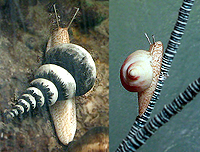 Gastropods (snails and slugs) are molluscs that typically secrete a single coiled or spiral external shell; slugs are basically snails that don’t secrete a shell. The internal organs include a heart, a digestive system, gills and a nervous system. Many shellfish that don’t especially look like snails, such as conches and whelks are also gastropods. When endangered, a snail may retreat into its shell for protection. Snails move with a large muscular foot beneath the shell, the name gastropod meaning “stomach foot”. A rasping “tongue” called a radula is located at the front of the foot. The radula is used to scrape algae or plant matter in herbivorous snails and to bore through the protective shells of prey in carnivorous snails. Snails were common in the Ordovician and are one of the most successful animal groups today, with well over 60 000 species living in the seas, freshwater, and on land, from the equator to near polar conditions.
Gastropods (snails and slugs) are molluscs that typically secrete a single coiled or spiral external shell; slugs are basically snails that don’t secrete a shell. The internal organs include a heart, a digestive system, gills and a nervous system. Many shellfish that don’t especially look like snails, such as conches and whelks are also gastropods. When endangered, a snail may retreat into its shell for protection. Snails move with a large muscular foot beneath the shell, the name gastropod meaning “stomach foot”. A rasping “tongue” called a radula is located at the front of the foot. The radula is used to scrape algae or plant matter in herbivorous snails and to bore through the protective shells of prey in carnivorous snails. Snails were common in the Ordovician and are one of the most successful animal groups today, with well over 60 000 species living in the seas, freshwater, and on land, from the equator to near polar conditions.
Graptolites (extinct)
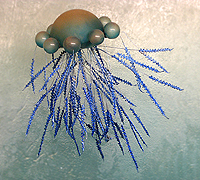 Graptolites are extinct small colonial animals. They are related to vertebrates like us, but more like cousins than ancestors. The fossils are almost always found preserved as flattened impressions on rock surfaces, which is where their name comes from (Greek for “written rock”, due to looking like writing on rocks). Graptolites were most successful in the Ordovician and went extinct in the late Carboniferous.
Graptolites are extinct small colonial animals. They are related to vertebrates like us, but more like cousins than ancestors. The fossils are almost always found preserved as flattened impressions on rock surfaces, which is where their name comes from (Greek for “written rock”, due to looking like writing on rocks). Graptolites were most successful in the Ordovician and went extinct in the late Carboniferous.
The reconstruction of the graptolite in this diorama is now considered wrong. Not only has no such structure ever been recovered, but the anatomy of many colonies precludes it, with species either lacking or possessing nemas (the "string" projecting out of their distal end that is depicted in the model as attaching to the float) that are too short to serve this purpose. Additionally, studies of graptolite hydrodyamics show that many species possessed structures that would have shifted the orientation or increased drag on individual colonies, but which would not make functional sense in a radial, multi-colony reconstruction. Graptolites are now thought to have been free swimming, singular entities (note: each colony housed multiple zooids, obviously). Allthough it is possible that some species very rarely formed radial clusters, if this is biological, rather than a taphonomic artifact, it does not represent their background condition. For more information about graptolites check out this scientific article. And these two: "Synrhabdosomes" and Graptolite ecology
With thanks to Jason Loxton from Cape Breton University for updating the information about graptolites.
Starfish
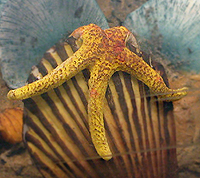 Starfish are predatory echinoderms, the group that also includes groups such as sea urchins and crinoids. They have fivefold radial symmetry and a hydraulic water vascular system. This water vascular system exists only in echinoderms, and it includes thousands of tube. The tube feet do not allow very quick movement; three metres a minute is a good pace for a starfish. Tub feet are also used to pry open the shells of their most common prey, oysters and clams. Once the shell has been opened, the starfish extends one of its two stomachs into the shell and engulfs the animal. Starfish fossils from the late Cambrian are known, but they are not very common in the fossil record.
Starfish are predatory echinoderms, the group that also includes groups such as sea urchins and crinoids. They have fivefold radial symmetry and a hydraulic water vascular system. This water vascular system exists only in echinoderms, and it includes thousands of tube. The tube feet do not allow very quick movement; three metres a minute is a good pace for a starfish. Tub feet are also used to pry open the shells of their most common prey, oysters and clams. Once the shell has been opened, the starfish extends one of its two stomachs into the shell and engulfs the animal. Starfish fossils from the late Cambrian are known, but they are not very common in the fossil record.
Trilobites (extinct)
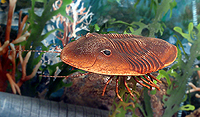 Trilobites are very well-known, probably the most famous prehistoric animals after dinosaurs. They were primitive crustacean-like animals that secreted a segmented exoskeleton. Very succcessful during their heyday in the Ordovician, there are over 17 000 known species in the fossil record. They ranged in size from one millimetre to more than 70 centimetres long and had all manner of lifestyles in all sorts of marine environments, from scavengers to grazers to predators. A few swam hile most walked on the bottom of the oceans or burrowed in the sediments. Trilobites evolved the first sophisticated visual system. Their name (which means “three lobed”) refers to the three lobes that run from front to back; one central (axial) and two side or pleural lobes. All trilobites have a head (cephalon), thorax and tail (pleuron), and paired jointed legs on the ventral (“bottom”) surface. Like crustaceans, each of these legs has two branches, one a gill and the other for walking or feeding. Trilobites suffered many reductions in diversity during their history, possibly due to evolving predators such as cephalopods (see below) and sharks, and many evolved defensive spines. after almost going extinct during the mass extinction of the Devonian (359 million years ago), finally went extinct at the end of the Permian(251 million years ago), the greatest mass extinction in Earth’s history.
Trilobites are very well-known, probably the most famous prehistoric animals after dinosaurs. They were primitive crustacean-like animals that secreted a segmented exoskeleton. Very succcessful during their heyday in the Ordovician, there are over 17 000 known species in the fossil record. They ranged in size from one millimetre to more than 70 centimetres long and had all manner of lifestyles in all sorts of marine environments, from scavengers to grazers to predators. A few swam hile most walked on the bottom of the oceans or burrowed in the sediments. Trilobites evolved the first sophisticated visual system. Their name (which means “three lobed”) refers to the three lobes that run from front to back; one central (axial) and two side or pleural lobes. All trilobites have a head (cephalon), thorax and tail (pleuron), and paired jointed legs on the ventral (“bottom”) surface. Like crustaceans, each of these legs has two branches, one a gill and the other for walking or feeding. Trilobites suffered many reductions in diversity during their history, possibly due to evolving predators such as cephalopods (see below) and sharks, and many evolved defensive spines. after almost going extinct during the mass extinction of the Devonian (359 million years ago), finally went extinct at the end of the Permian(251 million years ago), the greatest mass extinction in Earth’s history.
Other notable inhabitants of the Ordovician that are not in the diorama
Conodonts (extinct)
Conodonts were eel-like chordates or perhaps vertebrates from one to 40 centimetres in length. For many years they were only known by their commonly-found “teeth”, which are possibly filter-feeding structures. The rest of the body was soft-tissued and did not usually fossilize, making the conodonts a mystery until a few rare full-body fossils were recently found. Although their body shape is now known, not much else about them is. They survived the Permian mass extinction, but finally went extinct at the end of the Triassic.
Fish
The earliest vertebrates (animals with backbones) were the agnathans, or jawless fish, who were up to 30 centimetres long. Although they had developed specialized gills that served only for respiration (our earlier ancestors used the same structures for respiration and feeding), they didn’t have anything like jaws and sported a slitlike mouth. Ostracoderms, the dominant fish at the time, had heavy protective armour plating. This contributed t their being slow, weak swimmers. Without jaws, they fed by quickly opening their mouths to gulp prey in or by scraping food off of a surface. They were not very successful during the Ordovician, and it wasn’t until the Silurian and the evolution of jaws that fish began to dominate the oceans. When the jawed fish evolved the jawless species began to decline and today there are perhaps a hundred species of jawless fish left, such as the lamprey and hagfish.
Stromatolites
Stromatolites are structures formed when sedimentary particles get caught in films of microorganisms (especially cyanobacteria/blue-green algae). A new film grows over the particles, and new particles get caught in that film, and o the stromatolite grows over time. They can range in size from that of your finger to your house. When multicellular animals appeared stromatolites began to decline in numbers and diversity, most likely due to grazing. The oldest stromatolite fossil dates back to over 2,7 billion years ago, and they still exist in very salty waters, where the salt may prevent animals from grazing.

